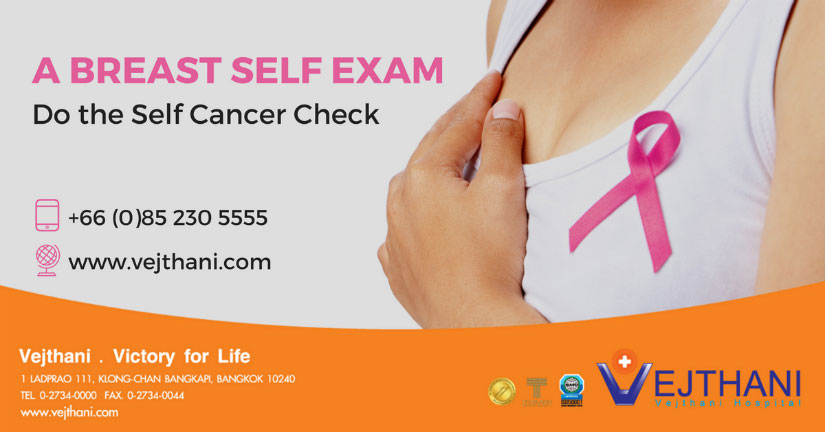
Health Articles
A Breast Self Exam: Do the Self Cancer Check


A breast self-exam is a check-up a woman does at home to look for changes or problems in the breast tissue. Adult women of all ages are encouraged to perform breast self-exam at least once a month.
“Forty percent of diagnosed breast cancers are detected by women who feel a lump, so establishing a regular breast self-exam is very important.”
The World Health Organization states that Breast self-examination (BSE) is of great potential value for the early detection of breast cancer, especially in areas where mammography and regular examinations by physicians are not practicable.
Breast self-exam helps you to be familiar with how your breasts look and feel so that you can alert your healthcare professional if there is any changes.
3 Ways on How to do Breast Self Examination
1. In Front of the Mirror
- Stand undressed from the waist up in front of a large mirror in a well-lit room.
Look at your breasts. Don’t be alarmed if they do not look equal in size or shape. Most women’s breasts aren’t. With your arms relaxed by your sides, look for any changes in size, shape, or position, or any changes to the skin of the breasts. Look for any skin puckering, dimpling, sores, or discoloration. Inspect your nipples and look for any sores, peeling, or change in the direction of the nipples. - Next, place your hands on your hips and press down firmly to tighten the chest muscles beneath your breasts. Turn from side to side so you can inspect the outer part of your breasts.
- Then bend forward toward the mirror. Roll your shoulders and elbows forward to tighten your chest muscles. Your breasts will fall forward. Look for any changes in the shape or contour of your breasts.
- Now, clasp your hands behind your head and press your hands forward.
Again, turn from side to side to inspect your breasts’ outer portions. Remember to inspect the border underneath your breasts. You may need to lift your breasts with your hand to see this area. - Check your nipples for discharge (fluid). Place your thumb and forefinger on the tissue surrounding the nipple and pull outward toward the end of the nipple. Look for any discharge. Repeat on your other breast.
2. In the Shower
- It is helpful to have your hands slippery with soap and water. Check for any
lumps or thickening in your underarm area. Place your left hand on your hip and reach with your right hand to feel in the left armpit. Repeat on the other side. - Check both sides for lumps or thickenings above and below your collarbone.
- With hands soapy, raise one arm behind your head to spread out the breast
tissue. Use the flat part of your fingers from the other hand to press gently into the breast. Follow an up-and-down pattern along the breast, moving from bra line to collarbone. Continue the pattern until you have covered the entire breast. Repeat on the other side.
3. Lying Down
- Lie down and place a small pillow or folded towel under your
right shoulder. Put your right hand behind your head. Place your left hand on the upper portion of your right breast with fingers together and flat. Body lotion may help to make this part of the exam easier. - Think of your breast as a face on a clock. Start at 12 o’clock and move toward
1 o’clock in small circular motions. Continue around the entire circle until you reach 12 o’clock again. Keep your fingers flat and in constant contact with your breast. When the circle is complete, move in one inch toward the nipple and complete another circle around the clock. Continue in this pattern until you’ve felt the entire breast. Make sure to feel the upper outer areas that extend into your armpit. - Place your fingers flat and directly on top of your nipple. Feel beneath the
nipple for any changes. Gently press your nipple inward. It should move easily.
Interestingly, cancerous tumors are more likely to be found in certain parts of the breast over others. If you divide the breast into 4 sections, the approximate percentage of breast cancers found in each area are (in clockwise pattern):
- 41% upper, outer quadrant
- 14% upper, inner quadrant
- 5% lower, inner quadrant
- 6% lower, outer quadrant
- 34% in the area behind the nipple
Almost half occur in the upper outer quadrant of the breast, towards the armpit. Some physicians refer to this region as the “tail” of the breast and encourage women to examine it closely.
The best time to do a self-breast exam is about 3 – 5 days after your period starts. Your breasts are not as tender or lumpy at this time in your monthly cycle. If you have gone through menopause, do your exam on the same day every month
What Should I Do If I Find a Lump?
See your health care provider if you discover any new breast changes. Conditions that should be checked by a doctor include:
- An area that is distinctly different from any other area on either breast
- A lump or thickening in or near the breast or in the underarm that persists through the menstrual cycle
- A change in the size, shape, or contour of the breast
- A mass or lump, which may feel as small as a pea
- A marble-like area under the skin
- A change in the feel or appearance of the skin on the breast or nipple (dimpled, puckered, scaly, or inflamed)
- Bloody or clear fluid discharge from the nipples
- Redness of the skin on the breast or nipple
It is important to remember that most breast lumps are non-cancerous (benign) and finding a lump could be alarming. However, a breast lump can be a sign of cancer, so you should always seek a medical evaluation of any lumps or swelling you discover on your breasts.
Although associated with women, breast tissue is present in both males and females. Your hormones affect this tissue. Hormonal changes can cause lumps to form and in some cases, to naturally disappear. You can develop lumps at any age. Some babies develop breast lumps due to the estrogen they get from their mothers during birth. These generally clear up as the estrogen leaves their bodies. Pre-pubescent girls sometimes get lumps that feel tender. These later clear up naturally during puberty. Adolescent boys can also get breast lumps during puberty. These are temporary and usually disappear in a few months as well.
Vejthani Hospital Breast Center has a team of specialist with the head of the department being a special doctor in the field of breast oncology, surgery and treatment. The specialist will help you spot the lump and recognize if it is alarming or not. The lump will be evaluated to determine whether it is non-cancerous (benign) or unfortunately cancerous.
Treatment could either be non-invasive such as medications or sometimes the lump just disappears naturally as what was stated above but on the other hand, surgical intervention might be needed for benign lumps. Whereas, the cancerous lumps could be treated in so many ways such as chemotherapy, radiation therapy, surgical intervention and many more or it could be a combination of treatments. Therefore, as soon as you find a lump, it is better for you to consult your doctor just to be sure. Furthermore, by using this new breast surgery for breast cancer patients Vejthani Hospital allows them not to lose their breasts as the same time. Through this new breast surgery performed at Vejthani Hospital, patients are able to keep their breasts as well as receive oncological treatment.
For inquiries or appointment Vejthani Hospital Breast Clinic is located at third floor or contact us through: email int_mkt@www.vejthani.com; Tel+66 (0) 2734-0000 ext. 4500/4501; Fax +66 (0) 2734-0375.

























